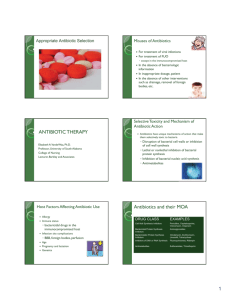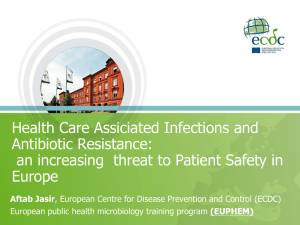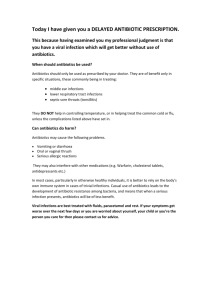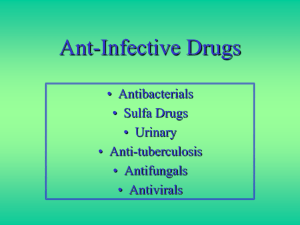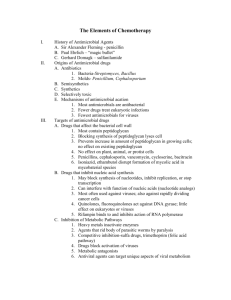Antibiotics 79-90
advertisement
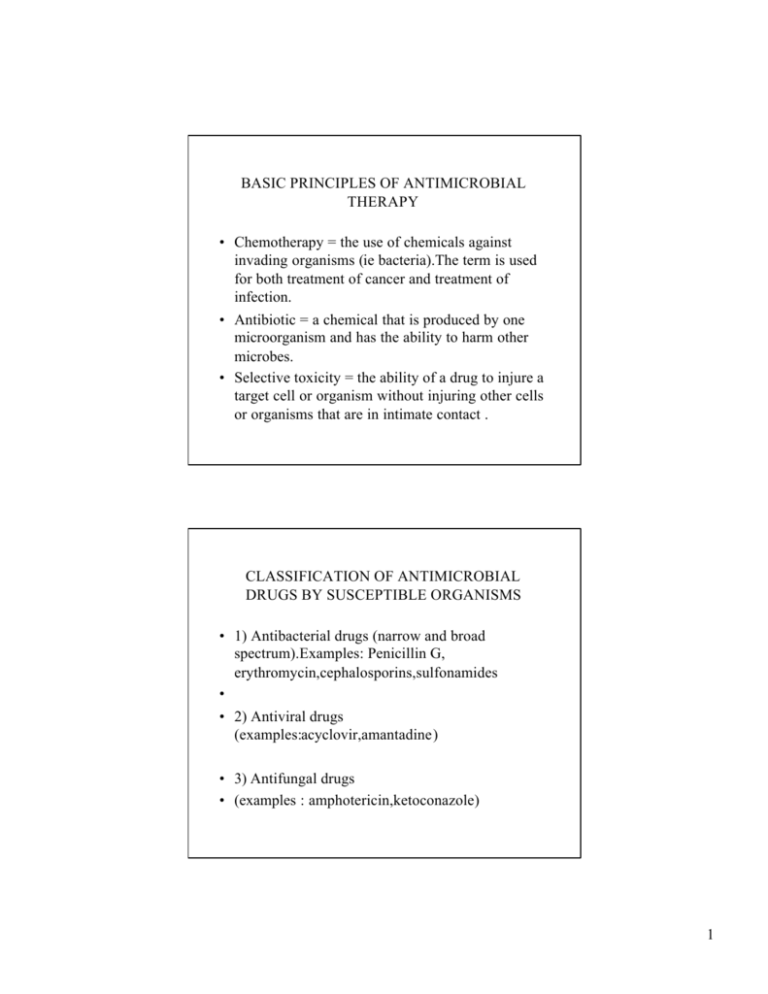
BASIC PRINCIPLES OF ANTIMICROBIAL THERAPY • Chemotherapy = the use of chemicals against invading organisms (ie bacteria).The term is used for both treatment of cancer and treatment of infection. • Antibiotic = a chemical that is produced by one microorganism and has the ability to harm other microbes. • Selective toxicity = the ability of a drug to injure a target cell or organism without injuring other cells or organisms that are in intimate contact . CLASSIFICATION OF ANTIMICROBIAL DRUGS BY SUSCEPTIBLE ORGANISMS • 1) Antibacterial drugs (narrow and broad spectrum).Examples: Penicillin G, erythromycin,cephalosporins,sulfonamides • • 2) Antiviral drugs (examples:acyclovir,amantadine) • 3) Antifungal drugs • (examples : amphotericin,ketoconazole) 1 CLASSIFICATION BY MECHANISM OF ACTION • 1) Drugs that inhibit bacterial wall synthesis or activate enzymes that disrupt the cell wall. • 2) Drugs that increase cell membrane permeability (causing leakage of intracellular material) • 3) Drugs that cause lethal inhibition of bacterial protein synthesis. • 4) Drugs that cause nonlethal inhibition of protein synthesis (bacteriostatics). • 5) Drugs that inhibit bacterial synthesis of nucleic acids • 6) Antimetabolites (disruption of specific biochemichal reactions-->decrease in the synthesis of essential cell constituents). • 7) Inhibitors of viral enzymes. • Acquired resistance to Antimicrobial drugs. • Mechanisms: • 1) Microbes may elaborate drug-metabolizing enzymes (ie penicillinase). 2 • 2) Microbes may cease active uptake of certain drugs • 3) Microbial drug receptors may undergo change resulting in decreased antibiotic binding and action. • 4) Microbes may synthesize compounds that antagonize drug actions. • How is resistance acquired? • A) Spontaneous mutation • B) Conjugation • Use of antibiotics PROMOTES the emergence of drug-resistant microbes. • Suprainfection (or supeinfection) : a new infection that appears through the course of treatment for a primary infection. 3 • Delaying the emergence of resistance: • 1) Use antimicrobial agents only when needed. • 2) Use narrow-spectrum antibiotics whenever possible. • 3) Newer antibiotics should be reserved for situations in which older drus are dangerous or no longer effective. SELECTION OF ANTIBIOTICS • • • • Factors to take into consideration: 1) The identity of the infecting organism. 2) Drug sensitivity of the infecting organism 3) Host factors (ie site of the infection,status of host defenses). • Empiric therapy prior to completion of lab tests: • it may be necessary to begin treatment in patients with serious infections BEFORE the lab results. 4 • Take samples for culture PRIOR TO INITIATION of treatment. • HOST FACTORS • 1) Host defenses (immune system and phagocytic cells). • 2) Site of infection .To be effective an antibiotic must be present in the site of infection in a concentration greater than MIC (endocarditis,meningitis,abscesses) • 3) Age (infants and elderly highly vulnerable to drug toxicity). • 4) Pregnancy and lactation • 5) Previous allergic reactions • 6) Genetic factors (ie hemolysis in patients with G-6PD deficiency if given sulfonamides). • IMPERATIVE :patients should be instructed to take their medication for the entire prescribed course even though symptoms may subside before the full course has been completed. 5 • Antibiotic combinations : • the result may be additive,potentiative or antagonistic. • Additive response :one in which the antimicrobial effect of the combination is equal to the sum of the effects of the two drugs alone. • Potentiative interaction :one in which the effect of the combination is GREATER than the sum of the effects of the individual agents. • Antagonistic response : in certain cases the combination of two antibiotics may be less effective than one of the agents by itself (ie combination of a bacteriostatic with a bactericidal drug) • Disadvantages of antibiotic combinations • 1) Increased risk of toxic and allergic reactions • 2) Possible antagonism of antimicrobial effects. • 3) Increased risk of suprainfection 6 • 4) Selection of drug resistant bacteria. • 5) Increased cost. • PROPHYLACTIC USE OF ANTIMICROBIAL DRUGS • 1) Surgery (ie cardiac,orthopedic,GI tract surgery) • 2) Bacterial endocarditis • 3) Neutropenia • Other indications: young women with recurrent • urinary tract infection,prophylaxis against type A influenza with amantadine,lifelong prophylaxis of individuals who have had severe rheumatic carditis. • Misuses of antibiotics • 1) Attempted treatment of untreatable infection (viral infections) • 2) FUO • 3) Improper dosage 7 • 4) Treatment in absence of adequate bacteriologic information. • 5) Omission of surgical drainage. PENICILLINS • Mechanism of action : the drugs weaken the cell wall ,causing the bacterium to take up excessive amounts of water and then rupture. • Penicillinases (Beta-lactamases) : • enzymes that cleave the beta-lactam ring and thereby render penicillin and other beta-lactam antibiotics inactive 8 • Classification : • 1) Narrow-spectrum (penicillinase sensitive) • 2) Narrow-spectrum that are penicillinase resistant (antistaphylococcal) • 3) Broad-spectrum penicillins (aminopenicillins) • 4) Extended-spectrum penicillins (antipseudomonal ) PENICILLIN G • Antimicrobial spectrum : active against most gram-positive bacteria,gram-negative cocci (ie neisseria meningitis) and spirochetes.With few exceptions gram-negative bacteria are resistant. • Therapeutic uses : • 1)Pneumonia and meningitis caused by Streptococcus pneumonia • 2) Pharyngitis caused by Streptococcus Pyogenes • 3) Infectious endocarditisis (Streptococcus viridans) 9 • 4) Gangrene ,tetanus • 5) Syphilis (treponema pallidum). • Side Effects and toxicities :pain at the site of injection,neurotoxicity with too high plasma levels.Inadvertent intra-arterial injection can produce severe reactions (gangrene,necrosis) and must be avoided . PENICILLIN ALLERGY • Penicillins are the most common cause of drug allergy (1-10% of the patients will experience an allergic response).There is no direct relationship between the size of the dose and the intensity of allergic response. • Cross-sensitivity :5-10% of patients allergic to penicillins are also allergic to cephalosporins. 10 • Types of allergic reactions : • 1) Immediate (occuring in 2-30 minutes after administration) • 2) Accelerated (occur within 1-72 hours) • 3) Late reactions (days or even weeks) • Anaphylaxis (laryngeal edema,bronchoconstriction,severe hypotension) in 0.2% of patients.Treatment -->epinephrine+ respiratory support. • Skin tests for penicillin allergy :skin tests are employed to assess the currents risk of a severe reaction. • A) BPO-PL (delayed hypersensitivity) • B) MDM ( anaphylaxis) 11 MANAGEMENT OF PATIENTS WITH HISTORY OF PENICILLIN ALLERGY • ASK patients for previous history of allergy to penicillin. • If the patient refers to a positive history of allergy AVOID PENICILLINS entirely. • If the allergy is mild a CEPHALOSPORINE is often appropriate as alternative. • If the allergy is severe AVOID CEPHALOSPORINS. • For many infections VANCOMYCIN AND ERYTHROMYCIN are effective and safe. • PENICILLINASE-RESISTANT PENICILLINS (Antistaphococcal) • Resistant to beta-lactamases . • Examples :Methicillin,Nafcillin. • BROAD-SPECTRUM PENICILLINS • (Aminopenicillins) • 1) Ampicillin (Bordetella pertussis,E.Coli,Salmonella,Shigella).most common adverse effects :rash and diarrhea. 12 • • • • 2)Amoxicillin EXTENDED-SPECTRUM PENICILLINS (Antipseudomonal ) Used to treat infections with Pseudomonas Aeruginosa (ie Ticarcillin) • Penicillins combined with a beta-lactamase inhibitor : • ie Amoxicillin+ clavulanic acid =Augmentin CEPHALOSPORINS • The drugs are beta-lactamic antibiotics similar in structure and actions with penicillins.Broadspectrum antibiotics with low toxicity. • Mechanism of action :disruption of cell wall synthesis and consequent lysis of the cell. • Classification: • a) First generation :highly active against grampositive bacteria (staphylococci) • b) Second-generation : enhanced activity against gram-negative bacteria 13 • c) Third-generation : more active against gram negative aerobes (important activity against Pseudomonas Aeruginosa). • d)Fourth generation : highly resistant to betalactamases.Broad spectrum antibiotics. • ADVERSE EFFECTS • 1) Allergic reactions :rash that develops after days of treatment .Severe immediate reactions are rare. • 2) Bleeding :Five cephalosporins cause bleeding tendencies (cefamandole,cefmetazole, • cefoperazone,cefotetan and moxalactam).Two mechanisms involved: reduction of prothrombin levels and impairment of platelet aggregation (only with moxalactam). • 3) Thrombophlebitis :it may develop during IV infusion (-->change the infusion site). • 4) Pain at sites of IV infusion. • Drug interactions: • a) Alcohol -->disulfiram-like reaction (AVOID alcohol). 14 • b)Caution with drugs that promote bleeding (anticoagulants,thrombolytics). • Therapeutic uses :first and second generation are rarely drugs of choice for active infections.Third generation agents have qualities that make them the preferred agents for several infections (Pseudomonas aeruginosa,nosocomial infections,gonorrhea,proteus) Other inhibitors of cell wall synthesis • IMIPENEM • Relatively new beta-lactam antibiotic with very broad spectrum. • Antimiocrobial spectrum :highly active against gram-positive and gram-negative cocci .It is also the most effective beta-lactam antibiotic against anaerobic bacteria. • Pharmacokinetics :It is not absorbed from the GI tract.IV or IM administration. 15 • • • • ADVERSE EFFECTS (generally well tolerated) 1) GI effects (nausea,vomiting,diarrhea) 2) Hypersensivity reactions (rashes,pruritus) have occurred. • 3) Suprainfections with bacteria or fungi develop in about 4% of patients. • 4)Rarely seizures have occurred. • VANCOMYCIN • It is used only for serious infections due to toxicity. • Principal indications : antibiotic-associated pseudomembranous colitis (Clostridium difficile),infection with methicillin-resistant Staphylococcus aureus. • Adverse effects:ototoxicity,thrombophlebitis. 16 BACTERIOSTATIC INHIBITORS OF PROTEIN SYNTHESIS • TETRACYCLINS • Broad spectrum antibiotics. • Mechanism of action :supression of bacterial growth by inhibiting protein synthesis. • Therapeutic uses • 1) Treatment of infectious diseases (rickettsial diseases--> Rocky mountain spotty fever,typhus fever,Q fever,infections caused by chlamydia trachomatis,brucellosis,cholera,pneumonia caused by Mucoplasma pneumonia,Lyme disease, (continued) • gastric infections with Helicobacter Pylori) • 2) Treatment of Acne (orally and topically for severe acne vulgaris). • 3) Peptic ulcer disease (combination of tetracyclines,metronidazole and bismuth salicylate against Helicobacter Pylori). • Absorption: the drugs should NOT be administered together with calcium supplements,milk products,iron supplements, 17 (continued) • magnesium-containing laxatives,antacids (formation of chelates reduces absorption). • ADVERSE EFFECTS • 1) Gastrointestinal irritation (burning,nausea,vomiting,diarrhea) • 2) Effects on bones and teeth (teeth discoloration in children under 5 years old.The drugs can also suppress long-bone growth in premature infants.The effect is reversible). (continued) • 3) Suprainfection (C. difficile pseudomembranous colitis ,fungus infections usually with Candida albicans) • 4) Hepatotoxicity (fatty infiltration of the liver) • 5) Renal toxicity (the drugs may exacerbate renal dysfunction in patients with pre-existing kidney dysfunction ) • 6) Photosensitivity (the drugs increase sensitivity of skin to UV radiation). 18 MACROLIDES • ERYTHROMYCIN • Mechanism of action : inhibition of protein synthesis. • Antimicrobial spectrum :(similar to penicillins) effective against most gram-positive bacteria and against some gram-negative. • Therapeutic uses • 1) Legionella pneumophila pneumonia (legionnaires’ disease). (continued) • • • • • 2) Whooping cough (Bordetella Pertussis) 3) Corynebacterium diptheriae (Diptheria) 4) Chlamydial infections 5) Mucoplasma pneumoniae pneumonia. 6) Alternative to Penicillin G in patients with penicillin allergy. 19 • ADVERSE EFECTS • 1) GI effects (nausea,vomiting diarrhea) • 2) Liver injury (cholestatic hepatitis.Happens with erythromycin estolate in adults with pre-existing history of liver disease). • Drug interactions :CAUTION when combined with astemizole and terfenadine (antihistamines),theophyline ,warfarin (anticoagulant),carbamazepine (anticonvulsant). (continued) • Erythromycin antagonizes the effects of chloramphenicol and clindamycin. • CLINDAMYCIN • Mechanism of action : inhibition of protein synthesis. • Antimicrobial spectrum :anaerobic bacteria (gram negative and gram-positive) 20 • ADVERSE EFFECTS • 1) Antibiotic associated pseudomembranous colitis (symptoms include profuse watery diarrhea,abdominal pain,fever and leucocytosis).Stools often contain mucus and blood). • 2) Hypersensitivity reactions (rashes). • CHLORAMPHENICOL • A broad spectrum antibiotic with the potential of causing FATAL aplastic anemia.Use of the drug is limited to treatment of severe infections for which less toxic drugs are ineffective. 21 AMINOGLYCOSIDES • Mechanism of action :disruption of bacterial protein synthesis. • Antimicrobial spectrum : aerobic gram-negative bacilli (E.Coli,Klebsiella pneumoniae,Proteus Mirabilis,Pseudomonas Aeruginosa).The drugs are inactive against most gram-positive bacteria.the drugs are ineffective against anaerobes. • ADVERSE EFFECTS • 1) Ototoxicity • 2) Nephrotoxicity • Examples of drugs :Gentamicin,Tobramycin,Amicacin. 22 SULFONAMIDES AND TRIMETHOPRIM • SULFONAMIDES • Mechanism of action :suppression of bacterial growth by inhibiting synthesis of of folic acid (required for the synthesis of DNA,RNA,proteins) • Antimicrobial spectrum :broad antibiotics • Therapeutic uses :urinary tract infections • ADVERSE EFFECTS • 1) Hypersensitivity reactions.Mild reactions are common (rash,drug fever,photosensitivity).Stevens -Johnson syndrome. • 2)Hematologic effects (hemolytic anemia in patients with G-6PD deficiency). • 3) Kernicterus (a disorder in newborns caused by deposition of bilirubin in the brain).The drugs should NOT be given to infants under the age of 2 23 (continued) • months ,pregnant women near term or breastfeeding mothers. • 4) Renal damage from crystalluria. • TRIMETHOPRIM • Mechanism of action : inhibitor of dihydrofolate reductase (-->suppresses bacterial synthesis of DNA,RNA and proteins). • Therapeutic uses :it is approved only for initial treatment of acute uncomplicated urinary tract infections due to susceptible organisms (E.Coli,Proteus Mirabilis etc) • ADVERSE EFFECTS • Generally the drug is well tolerated. • Most common adverse effects include itching and rash. • GI reactions occur occasionally. 24 (continued) • Caution when administering the drug to patients with suspected folate deficiency-->danger of bone marrow suppression (thrombocytopenia,neutropenia, anemia). • TRIMETHOPRIM-SULFAMETHOXAZOLE • Therapeutic uses: urinary tract infections,otitis media,bronchitis,shingellosis,pneumonia ,Pneumocystis Carinii pneumonia. • ADVERSE EFFECTS • The combination is generally well-tolerated. • Most common adverse effects:nausea,vomiting,rash. • Infrequent but serious toxicities: hypersensivity reactions (including Stevens-Johnson Syndrome),blood dyscrasias,renal damage. 25 ANTITUBERCULUS DRUGS • ISONIAZID • Therapeutic uses : prophylaxis and treatment of tuberculosis. • ADVERSE EFFECTS • 1) Peripheral Neuropathy (dose-related) :peripheral paresthesias of hands and feet,cluminess,unsteadiness,muscle aches (->administer pyridoxine). • 2) Hepatotoxicity (incidence increases with age) • RIFAMPIN • Therapeutic use: treatment of tuberculosis and leprosy. • ADVERSE EFFECTS • 1) Hepatotoxicity • 2) Discoloration of body fluids (urine,sweat,saliva,tears are colored redorange).The effect is harmless. • Other drugs :Pyrazinamide,ethambutol. 26 FLUOROQUINOLONES • CIPROFLOXACIN • Mechanism of action : inhibits DNA replication • Therapeutic uses :infections of respiratory tract,GI tract,bones,joints,skin and soft tissues. • ADVERSE EFFECTS • Mild reactions include nausea,vomiting,diarrhea and CNS effects (dizziness,headache).Candida infections of the pharynx and the vagina may result.Rarely -->Achilles tendon rupture. METRONIDAZOLE • Mechanism of action :inhibition of nucleic acids synthesis. • Therapeutic uses: The drug is active against obligate anaerobes only.It is used in CNS infections,abdominal organs,bones,joints,skin,soft tissues and genitourinary tract.It is used in combination against Helicobacter Pylori. 27 MANAGEMENT OF POISONING • • • • • 1) Supportive care 2) Poison identification 3) Prevention of further absorption 4) Promotion of poison removal 5) Use of specific antidotes • SYRUP OF IPECAC • Action:induction of emesis. • Contraindications : following ingestion of strong acids or bases.Also it is contraindicated in comatose or delirious patients. 28 • ACTIVATED CHARCOAL • It is a substance that absorbs drugs and other chemicals .Charcoal particles cannot be absorbed into the blood.The charcoal-poison complex is eliminated in the stool. • GASTRIC LAVAGE • Some important antidotes: • 1) Deferoxamine-->acute and chronic iron toxicity. • 2) Dimercaprol-->metal poisoning (mercury,arsenic,gold,lead) • 3) Penicillamine-->Wilson’s disease. 29

